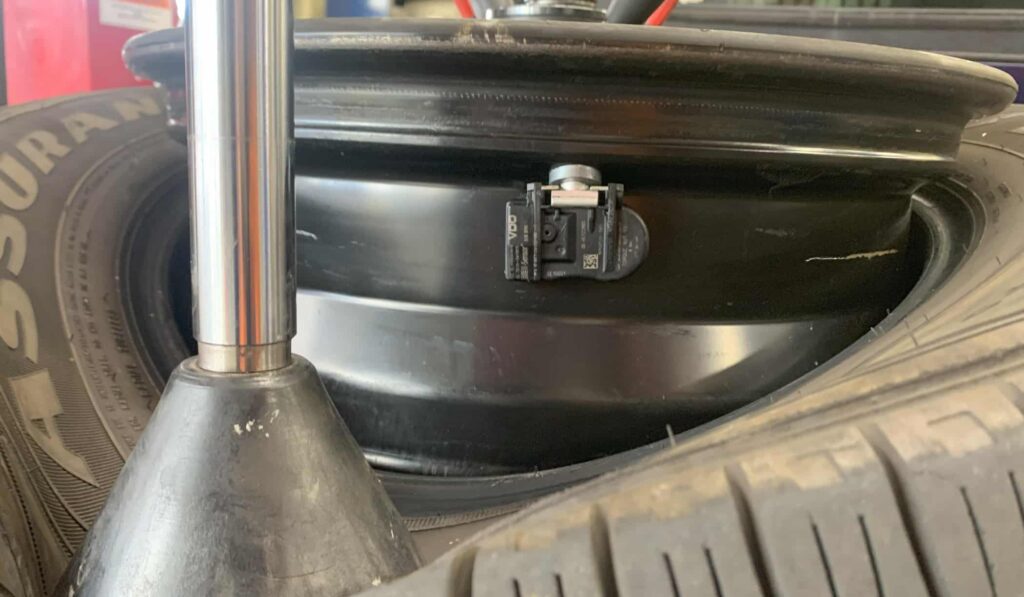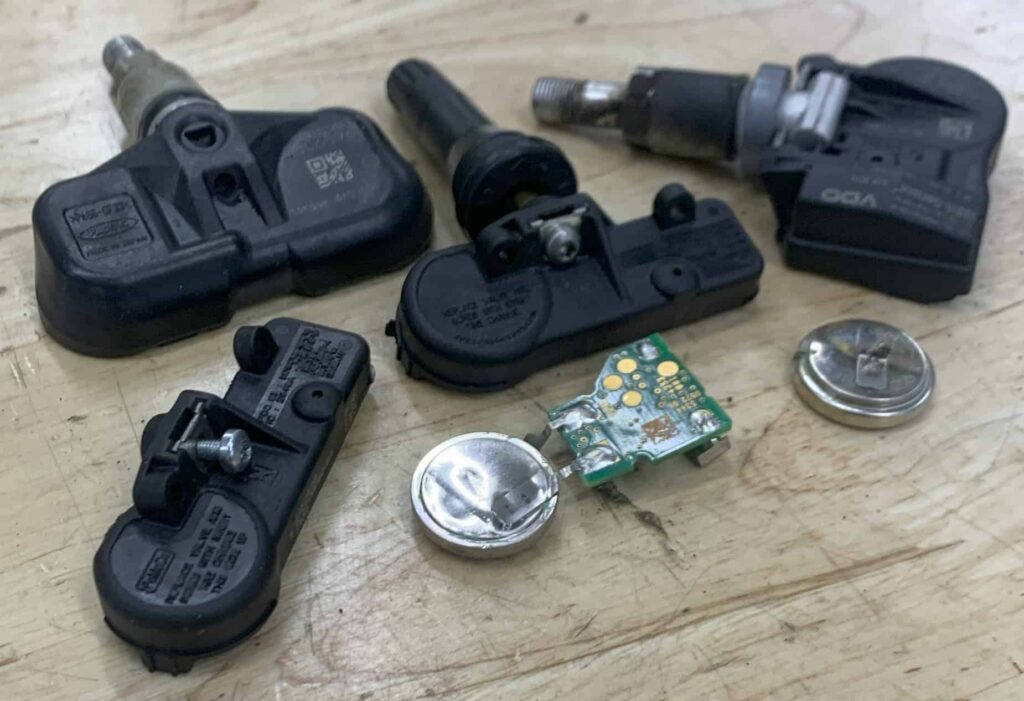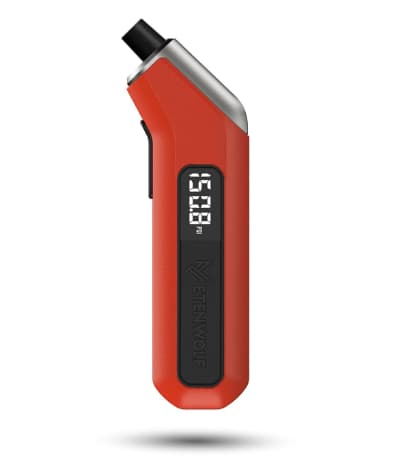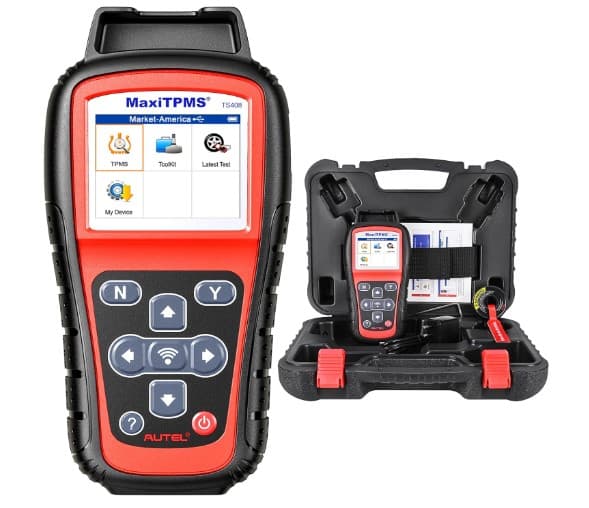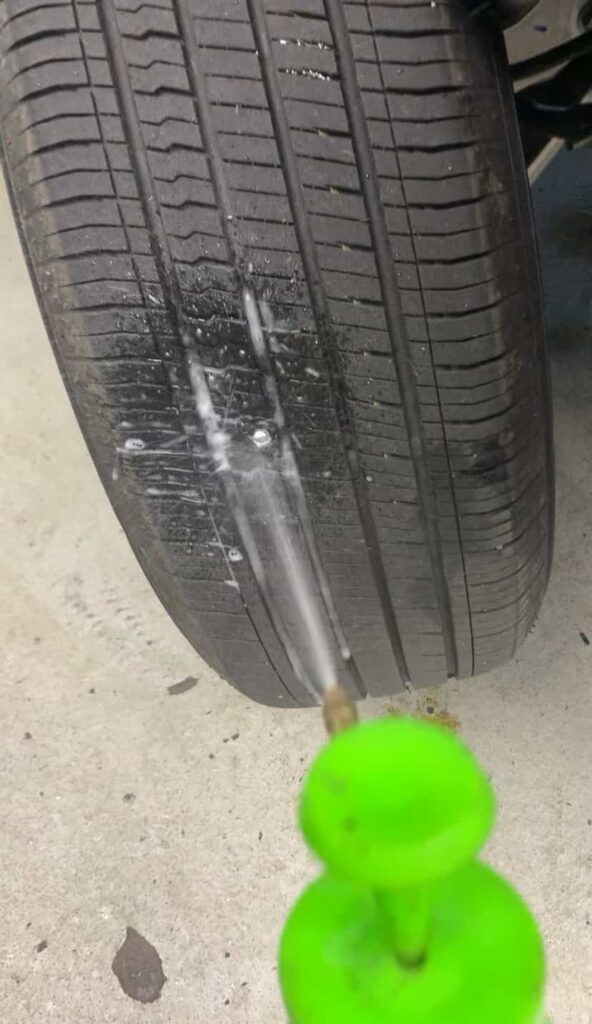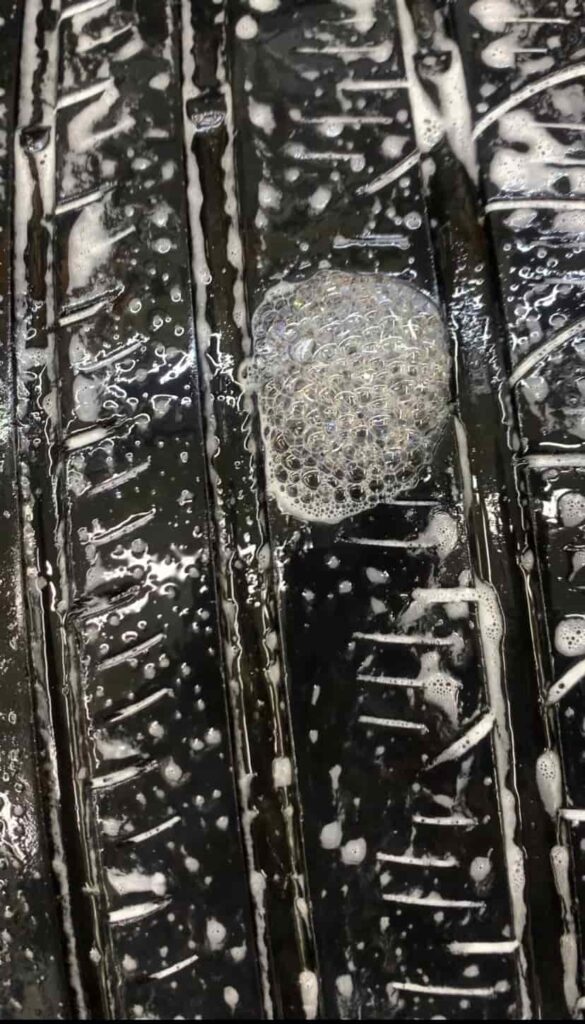Steps to Reset the Chevy Cruze Tire Light
Top up the four tires to the recommended cold air pressure.
For 5 to 10 minutes, drive the Chevy Cruze at speeds of at least 25 Mph.
Note that the Chevy Cruze does not come with a reset button for the tire pressure system.
Steps to Relearn the Chevy Cruze Tire Pressure SEnsors With a Tool
Fill each tire to a level of 40 Psi.
Scroll through the dashboard screens with the steering wheel controls to bring up the current tire air pressures.
Hold down the trip button.
A prompt will emerge, saying “Are you sure that you want to relearn?”
Short press the trip button for “Yes“.
The Chevy Cruze horn will beep twice, indicating that “Tire Learning Active” is now on the screen. You are now in tire pressure sensor relearn mode.
At the driver’s side front wheel (front left tire), position the TPMS relearn tool by the valve stem and press its trigger function. A single horn beep will confirm the tire position. Move onto the next tire.
Mirror this procedure at the right front tire, then the right rear tire and left rear tire, in that order.
Confirm the Chevy Cruze tire pressure sensor relearn process was successful by viewing the current tire pressure display screen.
Adjust each tire’s pressure back to the recommended air pressures found on the sticker inside of the driver side door panel.
Steps to Relearn The Chevy Cruze Tire Pressure Sensors Without a Tool
Relearning the tire pressure sensors is necessary so that the Chevy Cruze learns the positions of each tire on the car. Relearn the tire pressure sensors on the Chevy Cruze after tire rotations, tire repairs, or replacing any tire pressure sensors:
First, inflate all tires to a pressure of 40 Psi.
Turn the ignition to the “on” position, keeping the engine off.
On the dashboard display, enter the “Menu,” then navigate to “Vehicle Information” and find the “Tire Pressure Menu. that shows all the current tire pressure values”
Hold the SET/CLR (trip button) button until a prompt appears.
Confirm the relearn by selecting “Yes” to the message.
Two horn beeps will sound, showing that the relearn mode has begun, and the display will indicate “TIRE LEARNING ACTIVE.”
Start with the driver’s side front tire, and let out air from the tire until the horn beeps.
Follow the same step for the remaining tires in this order; front right, then the rear right, and lastly the rear left tire, each time waiting for the horn to beep after releasing air. To release air from a tire, push in the valve core in the valve stem.
Once the horn has sounded after the final tire, the Chevy Cruze relearning procedure is complete.
To confirm the procedure was successful, view the current tire pressure values on the display screen.
You can now turn off the ignition and readjust the tire pressures to the specified levels found on the sticker on the inside of the driver-side door.
CHEVY CRUZE TIRE PRESSURES
TIRE SIZE | FRONT PSI | REAR PSI |
195/65R15 | 35 | 35 |
205/55R16 | 35 | 35 |
225/45R17 | 35 | 35 |
225/40R18 | 35 | 35 |
What is the Chevy Cruze TPMS?
The Chevy Cruze tire pressure monitoring system (TPMS) functions as an essential safety feature, diligently tracking the air pressure levels in every tire. This system is built with four tire pressure sensors (one in each tire), a dedicated receiver module for the TPMS, and the engine control module which allows these components to communicate.
HOW DOES THE CHEVY CRUZE TPMS WORK?
Tire Pressure Detection in Chevy Cruze: Inside each tire of the Chevy Cruze is a tire pressure sensor. These sensors, not visible without tire removal are affixed at the base of the valve stems and comprise a small circuit board, radio transmitter, and battery all within a plastic casing. They measure the tire pressure and relay this information to the vehicle’s TPMS receiver module. It’s important to note that the Chevy Cruze’s spare tire lacks this sensor.
Operation of the TPMS Receiver Module: The TPMS receiver module in the Chevy Cruze is responsible for receiving tire pressure data from each tire’s sensor. It processes this information and then sends it to the ECM for further action.
The Engine Control Module’s Responsibilities: Acting as the brain of the Chevy Cruze the ECM plays a key role including monitoring tire pressure. It evaluates the tire pressure information against the car’s ideal pressure levels. Should it detect an underinflated tire, the ECM will initiate a warning for low tire pressure. The low tire pressure symbol is a yellow exclamation mark on the dashboard and information display screen.
WHAT TO DO RIGHT AWAY WHEN YOUR CHEVY CRUZE'S TIRE LIGHT ACTIVATES
When the Chevy Cruze dashboard displays the low tire pressure warning, promptly locate a safe place to pull over. After parking in a safe and flat location, visually examine each tire and use a tire pressure gauge for a manual air pressure check. Inflate the tires to align with the recommended air pressure settings.
REASONS WHY YOUR CRUZE'S LOW TIRE PRESSURE WARNING LIGHT COMES ON
Tires not inflated to the correct pressure
Mounting the spare tire
TPMS sensor batteries that are low on power or failing
Problems with the Chevy Cruze’s TPMS receiver module or ECM, including software issues
Electromagnetic field interference from other nearby vehicles or electronics
A drop in air temperature
Overloading the Cruze above its rated load or tow limit
Tire chains
Excessively dark tint on the car’s windows
Temperature fluctuations on the road surface
Using tires of incorrect sizes/mismatching tires
TPMS sensors getting damaged during new tire installation
Not resetting, relearning, or reprogramming the TPMS after tire replacement or rotation
WHY COLD TIRES ARE KEY TO ACCURATE PRESSURE ADJUSTMENT IN A CHEVY CRUZE
It’s advisable to adjust the tire pressure of the Chevy Cruze only when the tires are cold, meaning they haven’t been driven on for over 3 hours. The standard tire pressure recommendations are intended for tires in such a cold condition.
AVOIDING THE RISKS OF OVERINFLATING HOT TIRES
When tires are warm, either from recent use or due to higher external temperatures, their pressure readings tend to be higher than the actual level. Adjusting air pressure in this state can lead to overinflation.
UNDERSTANDING THE IMPACT OF ALTITUDE CHANGES ON TPMS LIGHT TRIGGERING
An increase in altitude correlates with a change in tire pressure. For every 1,000 feet of elevation climbed, there’s an estimated increase of 0.5 psi in tire pressure. In a scenario where a Chevy Cruze goes from sea level to a 14,000-foot elevation, the tire pressure might increase by about 7 psi. This increase in altitude does not result in the triggering of the Chevy Cruze’s low tire pressure alert because it is not triggered by overinflation.
Chevy Cruze Tire Pressure Sensor Batteries
Chevy Cruze features tire pressure sensors that are equipped with non-rechargeable, non-replaceable silver oxide batteries. These batteries are attached directly to the sensor’s circuit board and can endure 5 to 15 years or up to 150,000 miles of driving. When the battery is depleted, it necessitates the replacement of the entire sensor which then needs to be programmed and relearned to the Chevy Cruze ECM.
THE RISKS OF DRIVING A CHEVY CRUZE WITH AN ILLUMINATED TIRE LIGHT
We advise against driving your Chevy Cruze while the low tire pressure light is active, until the root cause of the alert is established. If a tire is losing air, it’s unsafe to drive. Conversely, if the tire light is on due to a dead tire pressure sensor battery, driving remains safe since it doesn’t signify an air pressure problem.
DETERMINING THE DRIVING DISTANCE LIMITS OF A CHEVY CRUZE WITH AN ACTIVE TIRE LIGHT
There’s no established safe driving distance or time for a Chevy Cruze when the low tire pressure light activates. As soon as you see the tire light on, it’s crucial to stop at the earliest opportunity, visually inspect every tire, and check the air pressure in each tire using a digital gauge. Do not only rely on the Chevy Cruze’s information display screens air pressure readings.
INSTALLING NEW WHEELS OR TIRES: HOW IT AFFECTS CHEVY CRUZE TIRE PRESSURE SENSORS
Two alternatives are available when new wheels or rims are mounted on a Chevy Cruze:
Reuse the original tire pressure sensors by fitting them onto the new wheels.
Set up new tire pressure sensors on these wheels and program them with the Chevy Cruze’s ECM using a TPMS programming device.
Moreover, it’s important to follow the sensor relearn process after new tires are put on the Cruze.
Why is the Chevy Cruze Tire Light Flashing?
In the Chevy Cruze, the TPMS’s self-diagnostic capability is a critical feature. A tire light that flashes and then remains on signals that there’s a problem with the connection between a tire pressure sensor and the Cruze’s ECM or TPMS receiver module, an issue referred to as a TPMS malfunction. This problem usually happens due to one of three scenarios:
A tire pressure sensor’s battery is either low or has completely died
The spare tire without a pressure sensor has been put in place of a normal tire
There’s been damage to a tire pressure sensor during the fitting of a new tire.
CAN THE CHEVY CRUZE TPMS BE DISABLED?
The removal of tire pressure sensors from the Chevy Cruze’s wheels doesn’t disable its tire pressure monitoring system. Such an action will lead to a TPMS malfunction, signified by the flashing of the low tire pressure alert light.
HOW TO USE A TPMS PROGRAMMING TOOL TO CHECK THE STATUS OF TIRE PRESSURE SENSORS
A TPMS diagnostic tool is essential for testing each tire pressure sensor on the Chevy Cruze. I find the Autel TPMS diagnostic tool particularly effective and recommend it. It allows for scanning and assessing each sensor, yielding a report that outlines the sensor’s battery status, signal strength, and the tire’s temperature. Any sensor exhibiting signs of trouble, such as a dwindling battery or feeble signal, must be replaced.
Can Weather Shifts Trigger the Chevy Cruze's Low Tire Light?
The low tire pressure warning light in the Chevy Cruze is often a result of changes in weather conditions and temperature. Tire pressure typically fluctuates by at least 1 Psi for every 10°F change in the ambient temperature. So, with a 40°F temperature drop, the air pressure in a Chevy Cruze’s tires could decrease from 35 Psi to 31 Psi, leading to the warning light coming on. Adjusting the tire pressure of your Chevy Cruze when the tires are in a cold state (before being driven on, or waiting 3 hours after driving) can help in preventing this issue from occurring frequently.
EXPLORING CAUSES FOR A LIT TIRE LIGHT DESPITE THE TIRES APPEARING NORMAL
It’s preferable to evaluate your tires’ air pressure using a gauge rather than basing your judgment on their appearance or the Chevy Cruze’s information display. If the low tire light deactivates after you inflate the tires to the prescribed pressure, this is a reliable sign that your TPMS (Tire Pressure Monitoring System) is operational and effective.
IS IT SAFE TO TEMPORARILY OVERINFLATE A PROBLEMATIC TIRE?
When the tire pressure light on your Chevy Cruze fails to reset after completing the TPMS reset steps and the tire pressure sensor relearning protocol, temporarily increase the tire pressure by at least 5 Psi. If the recommended tire pressure is 35 Psi, inflate them to 40 Psi. Drive the Cruze for a few miles at a speed over 25 Mph, then attempt the TPMS reset and the sensor relearning process again with the tires overinflated. After this, adjust the tire pressure back to the recommended level.
STEP-BY-STEP PROCESS TO LOCATE TIRE LEAKS USING SOAP AND WATER
For identifying the specific location of a leak in a tire, follow these steps:
Increase the pressure of the tire that’s leaking to 40 Psi.
Create a solution of water and liquid soap in a spray bottle.
Spray this soapy water liberally over the entire tire, focusing on the bead and valve stem.
Look for bubbles forming and trace them to their source to locate the leak.
DISCONNECTING THE BATTERY TO RESET THE CHEVY CRUZE'S ECU
In case the TPMS reset and sensor relearning for the Chevy Cruze don’t shut off the low tire pressure alert, disconnecting the car’s main 12-volt battery can reset any temporary TPMS error codes in the ECM.
Start by turning off the engine and all electronic devices (like the radio and lights).
Then, loosen the negative terminal’s hold down and remove the terminal from the battery.
Wait for a moment before reattaching and securing the terminal.
This sequence of three steps should turn off the low tire pressure light. However, if the light turns on again while driving, it is either due to a faulty tire pressure sensor or a tire that is losing pressure.
THE RELATIONSHIP BETWEEN TIRE PRESSURE AND GAS MILEAGE
The importance of adequate tire pressure for fuel efficiency in the Chevy Cruze cannot be overstated. It’s been found that a vehicle’s gas mileage decreases by 0.2% for each 1 psi reduction in the pressure of its tires. This means that a 5 psi drop in tire pressure could equate to a 1% decrease in fuel efficiency. This can lead to substantial extra fuel costs over time, in addition to a larger environmental footprint due to increased CO2 emissions.
NAVIGATING TIRE REPAIRS: ARE TIRE PLUGS SAFE?
Having worked as an automotive technician for a long time, I have regularly relied on tire plugs to repair tire punctures. Tire plugs are an excellent permanent solution, except when dealing with a tire’s sidewall or tires with completely worn tread. In instances of very large punctures, it’s preferable to either replace the tire or use a tire patch for repair.
TIRE EMERGENCIES: DO TIRE SEALANTS DAMAGE TIRE SENSORS?
For immediate temporary repairs of leaking tires, tire sealants can be a practical choice. But be aware that these sealants are typically in liquid form and pose a risk to the circuit board of the tire pressure sensor in the tire they are used on. It’s wise to have your tire pressure sensors evaluated after employing a tire sealant.
Everything in this article is applicable to all Chevrolet Cruze models and versions built between 2009-2019 including the Chevy Cruze Sedan and Hatchback.
Please note that this blog post contains Amazon affiliate links. This means that if you make a purchase through one of these links, we at TPMSRESET.COM may earn a small commission at no extra cost to you. We only recommend products that we personally use and believe in. Thank you for supporting us.



